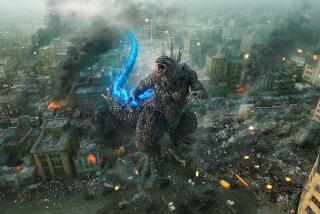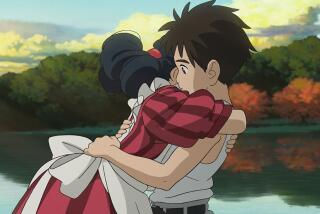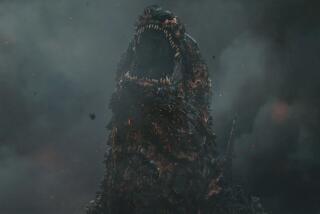A trip to a magic kingdom
We hear it before we see it, moving ponderously with heavy, thudding steps: Something big is coming our way. Clanging, banging, wheezing, it’s something magical and indescribable, something only Hayao Miyazaki, the great genius of today’s golden age of animation, could put on the screen.
What we’re hearing is “Howl’s Moving Castle,” an ambulatory collection of random housing elements that clomps around the countryside on great chicken’s feet, an enormous traveling Rube Goldberg contraption raised to the power of 10. It is, like the rest of the film it gives its name to, the product of a fearless and unfettered visual imagination, a cyclone of creativity that, like that enchanted castle, defies simple description.
Invariably box office sensations in their native Japan, Miyazaki’s films are starting to have an impact in this country as well: his previous hand-drawn work, “Spirited Away,” won the 2003 Oscar for best animated feature. His new film is just as magical, just as likely to make viewers feel they’ve never seen anything quite like it before.
Miyazaki’s gift for wonder, an ease with fantasy that makes enchantment second nature, is so great it obliterates differences in language. Playing exclusively at Hollywood’s El Capitan, “Howl” is being shown in a Japanese and a dubbed-into-English version overseen by Pixar. Each has its virtues and flaws, with the original understandably feeling more authentic, but in both cases the look is so overpowering we end up barely noticing which language is being used.
Based on a novel of the same name by veteran British fantasy writer Diana Wynne Jones, “Howl’s” story takes place, like Philip Pullman’s Dark Materials trilogy, in an alternate universe that is half fantasy, half familiar. Like fellow animator Katsuhiro Otomo’s recent “Steamboy,” its locale is reminiscent of late 19th century Europe, a world where everyday buildings and costumes share the screen with fantastic Jules Verne-type flying battleships and ordinary people have to cope with the incursions of witches and wizards into their lives.
And like much of Miyazaki’s work, including 1997’s “Princess Mononoke,” the first of his film’s to get significant American distribution, “Howl” is centered on the adventures of an intrepid young woman who gradually comes to know her own emotional strength. Its themes -- including the powers of love and kindness, the healing properties of the natural world and the horrific evils of war -- are strongly held, but they’re never allowed to overwhelm the remarkable visuals.
The intrepid woman in question is Sophie (voiced by Emily Mortimer in the English version), a hard-working, unassuming young person who is perfectly happy quietly sewing hats in a city that is jingoistically preparing for war.
On a walk to visit her sister, Sophie is accosted by a pair of leering soldiers only to be rescued by a dashing young man with long blond hair and a rock star’s good looks who unexpectedly shows her how to fly through the air and steals her heart in the process.
That turns out to be the wizard Howl (well voiced by current “Batman” Christian Bale), quite handsome and well aware of it, who lives in that castle and is reputed to literally eat the hearts of beautiful young women. He’s so cool he doesn’t break a sweat as he deals with sinister blob men who morph out of walls unaccountably wearing sporty straw boaters.
Those blobs are under the command of the sinister, opera-diva-sized Witch of the Waste (a terrific Lauren Bacall), who has enough of a crush on Howl to resent his attentions to Sophie. She puts a terrible curse on the young woman, turning her overnight into a 90-year-old crone (now voiced by Jean Simmons) who is so terrified by the change that she leaves the city to seek her fortune and end the curse.
Age seems to increase Sophie’s energy, not diminish it. She is soon being helped by a living scarecrow she calls Turniphead, gaining entrance to that castle, and coming to terms with a cranky fire demon named Calcifer who has a mysterious symbiotic relationship to Howl. (The demon is voiced by Billy Crystal, and having him resort to mood-destroying Catskills shtick of the “Hey, lady” variety is the dubbed version’s only major miscalculation.) More important, Sophie comes to share space with Howl, who, against expectation, turns out to be someone who needs her help as much as she needs his.
Miyazaki, who writes his own scripts, prefers a narrative structure that takes its time and is difficult to pin down. “Howl’s” storyline moves at an idiosyncratic pace, detouring to seemingly unrelated points before suddenly erupting into pure magic. The film follows a through line that is emotional, not logical, becoming a story beyond words we understand with our hearts more than our minds.
Parse it any way you like, Miyazaki’s gifts as an animator place him in a category of his own. To see his latest film is to be somehow reminded of Italians who could hear Verdi’s operas as soon as they were sung or English readers who could experience the novels of Dickens episode by episode.
Like those fortunate folk, we can have the excitement and joy of seeing new work by one of the greatest animators who ever lived just as soon as he creates it. Future generations will envy us our luck.
*
‘Howl’s Moving Castle’
MPAA rating: PG for frightening images and brief, mild language
Times guidelines: May be too intense for smaller children.
A Studio Ghibli production released by Walt Disney Pictures. Director Hayao Miyazaki. Producer Toshio Suzuki. Executive producer (U.S. version) John Lasseter. Screenplay by Hayao Miyazaki, based on the novel by Diana Wynne Jones. Music Joe Hisaishi. Running time: 1 hour, 58 minutes.
Exclusively at El Capitan Theatre, 6838 Hollywood Blvd., Hollywood. Japanese-language version with English subtitles screens Thursday and Sunday, 7 and 9:45 p.m. In general release next Friday.
More to Read
Only good movies
Get the Indie Focus newsletter, Mark Olsen's weekly guide to the world of cinema.
You may occasionally receive promotional content from the Los Angeles Times.











